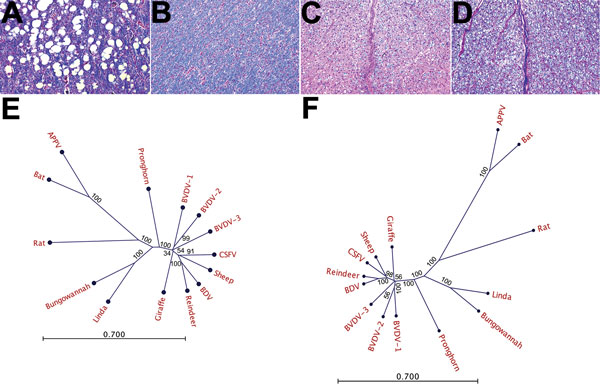Volume 23, Number 7—July 2017
Dispatch
Novel Pestivirus Species in Pigs, Austria, 2015
Figure 1

Figure 1. Histologic and phylogenetic examination in investigation of piglets with congenital tremor (CT) on a farm in southeastern Austria, 2015. A) Cerebellar white matter of CT-affected piglet showing multiple sharply bordered vacuoles but normal myelination (stained in blue; luxol fast blue/hematoxylin-eosin staining; original magnification ×10). B) Control piglet with normal cerebellar white matter (original magnification ×10). C) Spinal cord white matter in CT-affected piglet shows a severely reduced amount of myelin (original magnification ×10). D) Control piglet with normal myelination of the spinal cord white matter (original magnification ×10). E, F) Phylogenetic neighbor-joining analysis using the nucleotide (E) and polyprotein (F) sequences of the novel virus isolated from piglets, provisionally termed Linda virus (GenBank accession no. KY436034); approved pestivirus species BVDV-1 NADL (accession no. M31182.1), BVDV-2 890 (accession no. U18059.1), CSFV Alfort_187 (accession no. X87939.1), and BDV X818 (accession no. AF037405.1); and tentative species Bungowannah virus (accession no. EF100713.2), sheep pestivirus Aydin (accession no. NC_018713.1), pronghorn pestivirus (accession no. NC_024018.2), reindeer pestivirus (accession no. AF144618.2), giraffe pestivirus (accession no. NC_003678.1), BVDV-3 D32_00_HoBi (accession no. AB871953.1), APPV NL1 (accession no. KX929062.1), Rhinolophus affinis pestivirus (accession no. JQ814854.1), and Norway rat pestivirus (accession no. KJ950914.1). Assumed relationships between the species are shown in a radial branching diagram with numbers indicating the bootstrap values of 1,000 replicates in percentages. Scale bars indicate number of substitutions per site. BDV, border disease virus; BVDV, bovine viral diarrhea virus; CSFV, classical swine fever virus.